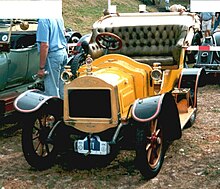


Dalgliesh-Gullane was a Scottish built car made by 'Haddington Motor Engineering' of Haddington, East Lothian from 1907 to 1908. [1] Little is known about this make because it was only produced for a short while. The company was owned by the Shearsmith family.
Only one type was made, a two-seater, and it is thought that only 14 were sold. The car was powered by a single cylinder, 1180 cc, 8 hp De Dion engine at the rear driving through a Cardan shaft which was unusual in those days when chain drive was more common.
Today only one remains. [1]
The vehicle shown on the picture appears to be the same vehicle that appeared in a Spanish Firestone calendar for 1977, (incorrectly being labelled "Dalgleish"), being featured on the Abril, Mayo, Junio (April, May, June) page. In that picture, the vehicle had a white on black number plate "S1231". It had a simpler radiator cap and had red panel decorative lining to the body and bonnet. The seat was simpler with a single circular arc on the sides and had no seat hood.